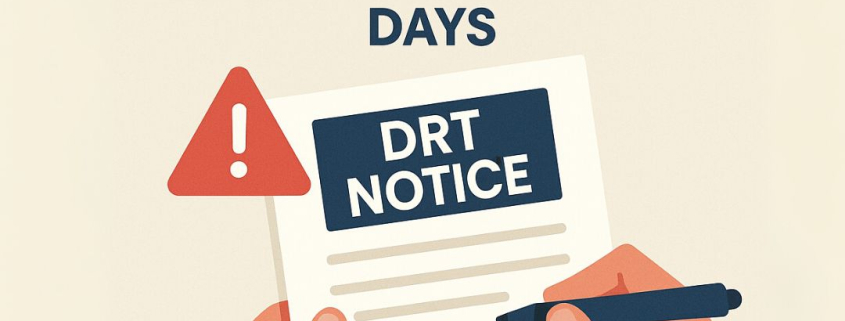Received a DRT Notice? Key Steps to Take Within 30 Days
Getting a DRT notice can feel scary and overwhelming. But don’t panic! Understanding what it means and taking the right steps quickly can protect your rights and property. LEGAL ASSIST is here to guide you through this challenging time with simple, practical advice.
What is a DRT Notice?
A DRT Notice is a formal legal document sent by banks or financial institutions when you haven’t paid back your loan. It’s issued under the Recovery of Debts and Bankruptcy Act, 1993. Think of it as the bank’s way of saying, “We’re taking legal action to get our money back.”
The main purpose of a DRT notice is to start the legal process of recovering money you owe. It also gives you a chance to respond or settle the debt before things get worse.
When Do Banks File DRT Cases?
Banks usually file DRT cases when your loan amount is more than 20 lakhs and you’ve stopped making payments. The process is straightforward – first, they send reminders and notices. If you still don’t pay, they file a case with the Debt Recovery Tribunal (DRT).
The DRT then hears your case quickly and decides if you must repay the money and how. If the DRT rules in favor of the bank, they can sell your assets or use a Recovery Officer to collect the money.
Your 30-Day Action Plan
Step 1: Understand Your Notice Immediately
The moment you receive a DRT notice, read it carefully. Figure out if it’s under the RDB Act or SARFAESI Act. A SARFAESI notice gives you 60 days to pay, while an RDB Act notice might need you to file a Written Statement.
LEGAL ASSIST recommends getting professional help at this stage because understanding legal language can be tricky.
Step 2: Collect All Your Documents
Gather every document related to your loan and property right away. This includes loan papers, bank statements, payment records, property deeds, and any letters you’ve exchanged with the bank. Check if there are any mistakes in how much money the bank says you owe.
Step 3: Get Legal Help Fast
Don’t wait to consult a lawyer who specializes in DRT cases. LEGAL ASSIST has experienced lawyers who can quickly assess your situation and tell you the best way forward. They’ll help you understand if you should file objections, try to settle, or challenge the bank’s action.
Waiting too long to get legal advice can cost you the chance to get interim relief or file important applications on time.
Step 4: Respond to the Notice
If your notice is under the SARFAESI Act, you have 60 days to write back with your objections. You can point out things like wrong amounts owed, improper procedures, or incorrect classification of your account as a bad loan.
Step 5: File Your Case in DRT
If the bank takes steps like taking possession of your property or planning an auction, you must file a Securitisation Application with the DRT within 45 days. This is your legal way to fight back.
Step 6: Explore Settlement Options
While preparing your defense, you can also try to negotiate a One-Time Settlement (OTS) with the bank. Sometimes banks are willing to accept less money than the full amount to close the case quickly.
Step 7: Ask for Interim Relief
When you approach the DRT, ask for interim relief along with your application. This can stop the bank from taking immediate action against your property while your case is being heard.
Important Legal Facts You Should Know
The DRT has special powers under the SARFAESI Act to handle cases involving debts of any amount. This means regular civil courts cannot interfere with DRT matters. The Supreme Court has made it clear that if the DRT has the power to act, civil courts cannot get involved.
Even people who are not the original borrower can approach the DRT in certain situations. For example, if you’re leasing property from someone who took a loan, you might be able to file a case if the lease was created before the mortgage.
What Happens If You Ignore the Notice?
Ignoring a DRT notice is the worst thing you can do. The court can proceed without you (called ex parte proceedings), and the bank can attach or sell your property. LEGAL ASSIST strongly advises against ignoring any legal notice.
Can You Challenge the Notice?
Yes, you can definitely challenge a DRT notice. You can file an application under Section 17 of the SARFAESI Act before the Debt Recovery Appellate Tribunal (DRAT). Having a good lawyer increases your chances of success.
Getting Professional Help
While you’re not legally required to have a lawyer, LEGAL ASSIST strongly recommends getting professional help. DRT cases involve complex procedures and legal requirements that are difficult to handle alone.
Our experienced team can help you understand your rights, prepare the right documents, and represent you effectively in court. We’ve helped many clients successfully challenge DRT notices and protect their properties.
Moving Forward
Receiving a DRT notice doesn’t mean you’ve lost everything. With the right approach and timely action, you can protect your interests and find a solution. The key is to act quickly, understand your options, and get professional help.
LEGAL ASSIST is committed to helping you navigate this challenging situation. Our lawyers understand the stress and anxiety that comes with legal notices, and we’re here to support you every step of the way.
Remember, you have rights and options. Don’t let fear or confusion stop you from taking action. Contact LEGAL ASSIST today to discuss your case and explore your options. With the right legal strategy and timely action, you can protect your assets and find a way forward.
The most important thing is to act within the first 30 days. Every day counts when dealing with DRT notices, so don’t delay in seeking professional help and understanding your options.





